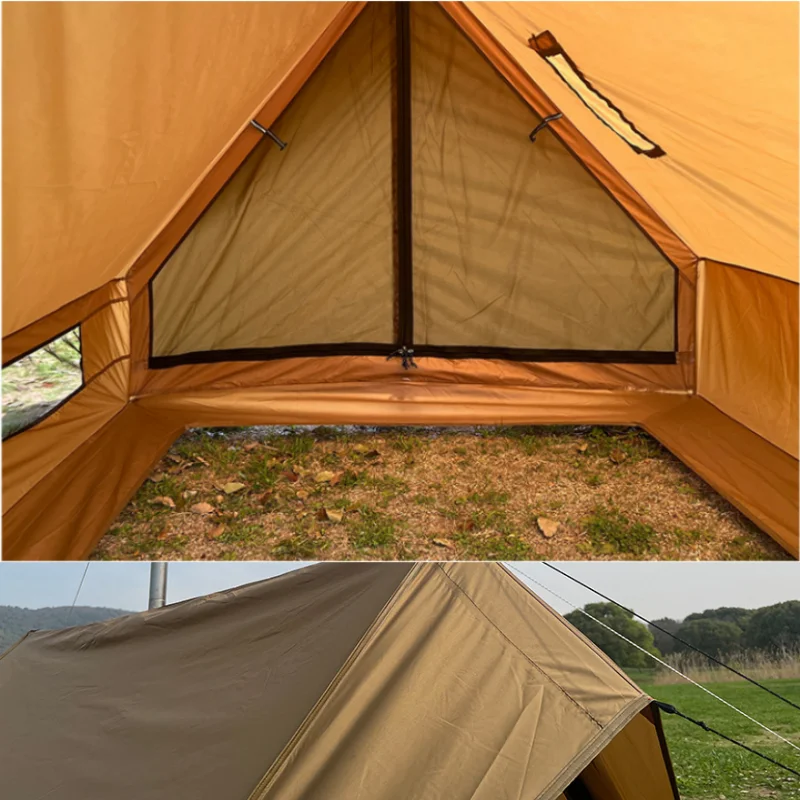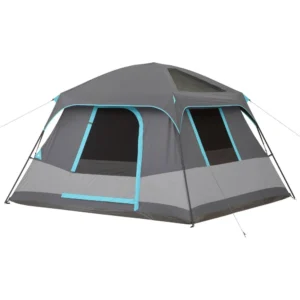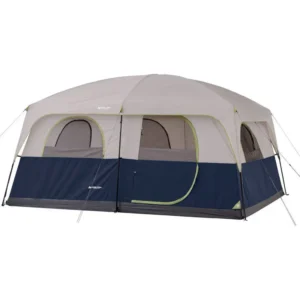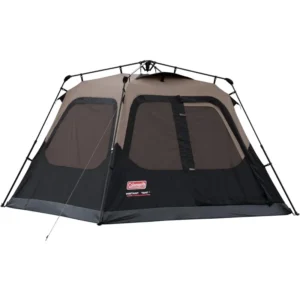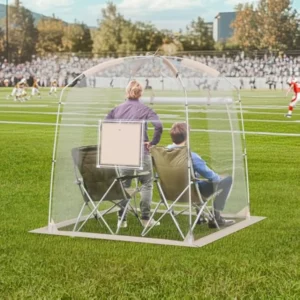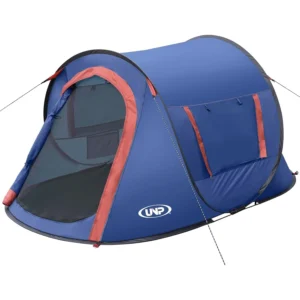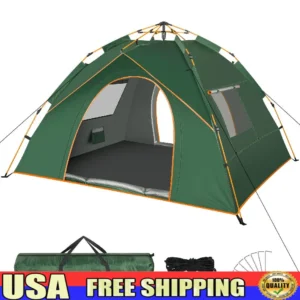Why Headroom Matters: The Undeniable Benefits of Tall Camping Tents
When it comes to car camping, one of the most significant but often overlooked features is tent height. A tall tent—generally defined as having at least 6 feet (180 cm) of peak height—can completely transform your camping experience from merely tolerable to genuinely enjoyable.
Imagine the frustration of spending a weekend hunched over or crawling in and out of your shelter. Now contrast that with the freedom of standing upright, changing clothes comfortably, and moving around naturally inside your temporary home. This simple difference in design has profound effects on comfort and convenience.
The benefits of tall tents for car camping extend beyond the physical:
- Easier dressing and changing clothes without the awkward crouch-and-shimmy dance
- Simplified organization of gear when you can fully stand to sort and arrange items
- Enhanced comfort during bad weather when you’re confined inside for extended periods
- Greater sense of spaciousness that reduces feelings of claustrophobia or confinement
- More dignified camping experience for those with mobility issues or back problems
Considering that the average adult man in the U.S. stands at about 5‘9” (175 cm) and the average adult woman at 5‘4” (162 cm), a tent with adequate standing room provides practical advantages for nearly everyone. Understanding different shelter options for two campers can help you evaluate whether a tall tent might be the right choice for your next adventure.
With so many tent designs and specifications on the market, finding the ideal standing-height tent requires understanding both the technical aspects of tent height and how different tent styles achieve it. Let’s explore what makes a tent truly “tall” and which designs maximize usable standing space.
Understanding True Headroom: Beyond the Peak Height Specification
When shopping for a tall tent, many campers make the mistake of focusing solely on the peak height specification. While this number is important, it doesn’t tell the whole story about usable headroom—the space where you can actually stand upright.
The true measure of a tent’s headroom is determined by several factors working together:
Wall design has perhaps the greatest impact on usable space. Vertical walls create much more standing room than sloped walls, even when peak heights are identical. For instance, a dome tent with a 6‘5” (196 cm) center height might only allow standing in a small central area, while a cabin tent of the same peak height could provide standing room throughout most of the interior.
Floor dimensions also play a crucial role in determining how much of the tent offers standing height. A larger floor plan generally allows for more standing area, particularly if combined with steep walls.
Roof shape affects how quickly height diminishes as you move away from the peak. Flat or slightly curved roofs maintain height better than sharply pitched designs.
For comfortable standing, look for tents with peak heights at least 3-4 inches (7-10 cm) above the tallest person’s height who’ll be using the tent. For average adults, this typically means seeking tents with peak heights of at least 6‘3” (190 cm), though taller individuals may need heights of 6‘6” (198 cm) or more.
Understanding these concepts will help you evaluate the different tent types we’ll explore next, each offering unique approaches to maximizing interior height.
Cabin Tents: Maximum Standing Room Throughout
Cabin tents stand out as the champions of headroom in the camping world. Defined by their nearly vertical walls and boxy, house-like shape, these shelters prioritize livable space above all else. The distinguishing feature is a frame system that creates walls at almost 90-degree angles to the floor, maximizing interior volume and standing space.
Most cabin tents offer impressive peak heights ranging from 6‘5” to 7’ (195-210 cm), but what truly sets them apart is that approximately 70-90% of their floor space provides full standing height. This means even tall adults can walk around freely throughout most of the tent rather than just in the center.
The rectangular footprint of cabin tents often includes room dividers, creating multi-room configurations that feel more like temporary homes than simple shelters. Many designs feature separate “bedrooms” and “living areas,” providing privacy for families or groups.
Advantages for car campers:
– Unmatched standing room throughout most of the interior
– Excellent space efficiency with near-vertical walls
– Room dividers for privacy in larger models
– Straight walls make furniture placement easier
– Windows positioned at comfortable viewing height
Limitations to consider:
– Typically heavier and bulkier when packed (often 20+ pounds/9+ kg)
– Longer setup time (usually 15-30 minutes with practice)
– Less wind resistance than lower-profile designs
– Require larger campsites due to bigger footprints
Cabin tents come in various sizes, with 4-person models typically offering about 64 square feet (6 square meters) of floor space, while 8-person versions may provide up to 140 square feet (13 square meters). The generous dimensions of tall stand-up camping tents make them ideal for extended stays or when camping comfort is a top priority.
Dome Tents with Enhanced Height: Balancing Space and Stability
Dome tents represent perhaps the most common tent design on the market, but standard domes rarely offer adequate standing height. However, manufacturers have created enhanced-height versions that maintain the dome’s inherent stability while providing improved headroom.
These modified dome designs achieve greater height through several engineering approaches:
– Extended center poles that push the peak higher
– Additional crossing poles that create a more elevated center section
– Hybrid designs combining dome elements with more vertical sidewalls
– “Extended dome” configurations with rectangular floor plans but curved roofs
Enhanced-height dome tents typically offer peak heights between 5‘8” and 6‘4” (172-193 cm), with about 20-40% of the floor area providing standing room. While this is significantly less than cabin tents, the dome structure compensates with superior stability in wind and easier setup.
The curved walls of dome camping tents gradually slope downward from the center peak, creating less overall standing space but a more aerodynamic profile. This makes enhanced-height domes an excellent middle-ground option that balances headroom with weather resistance.
Advantages for car campers:
– Better stability in wind compared to vertical-walled designs
– Typically faster and simpler setup (around 10-15 minutes)
– More affordable than similarly sized cabin tents
– Better heat retention due to less interior volume
– More compact packed size for transportation
Limitations to consider:
– Limited standing area concentrated in the center
– Sloped walls reduce usable interior space
– Wall curvature makes furniture placement more challenging
– Windows often positioned lower due to wall angles
For campers who want reasonable headroom without sacrificing weather performance or ease of setup, enhanced-height dome tents offer an attractive compromise between comfort and practicality.
Tunnel Tents: Linear Standing Space with Excellent Volume
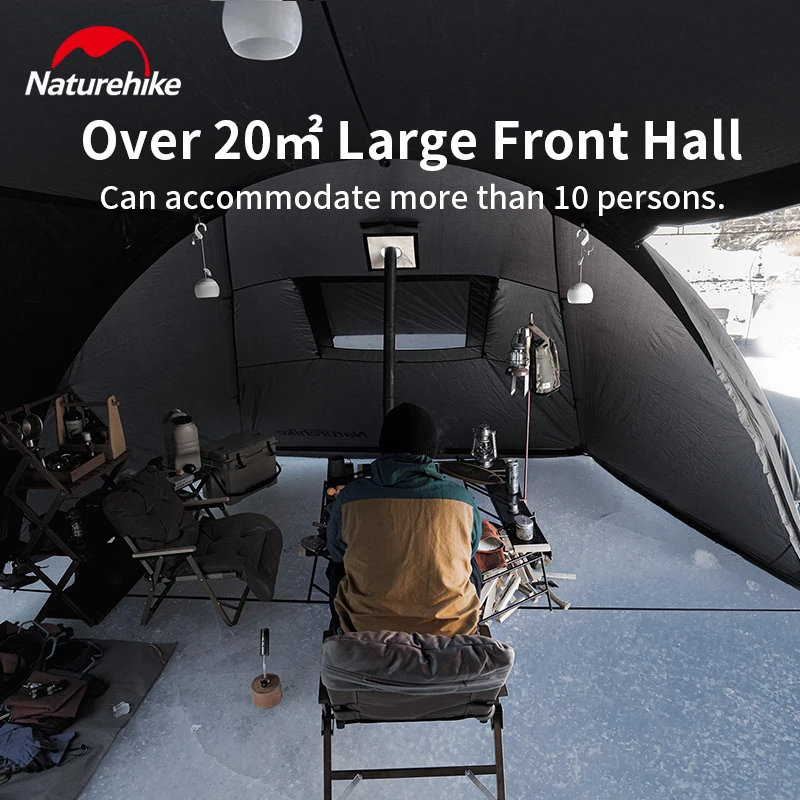
Tunnel tents feature a distinctive architecture based on a series of parallel hoops or poles that create a tunnel-like structure. This design creates a consistent ceiling height along the central axis of the tent, providing a “corridor” of standing room from one end to the other.
With typical peak heights ranging from 5‘6” to 6‘2” (168-188 cm), tunnel tents offer a unique distribution of headroom. Rather than concentrating standing height in the center (like domes) or throughout (like cabins), they provide a linear path of maximum height. This creates excellent usable volume for their weight and offers standing space where it’s often most needed—along the main traffic path through the tent.
Key features of tunnel tents:
– Excellent space-to-weight ratio compared to other tall tent designs
– Generous vestibules for gear storage at one or both ends
– Good ventilation options due to their elongated shape
– Efficient use of materials resulting in less weight per square foot of floor space
– Semi-vertical side walls providing more usable interior volume than domes
Setup considerations:
– Require proper staking and tensioning (15-25 minutes setup time)
– Orientation matters—should be positioned with the narrow end facing the wind
– Guy lines are essential for stability in adverse weather
– Usually easier to set up with two people
Tunnel tents excel when camping space is at a premium but headroom remains a priority. Their rectangular footprints make efficient use of campsite space, and their streamlined design handles moderate winds effectively when properly oriented and secured.
Pop-Up and Instant Tents: Quick Setup with Standing Room
For campers who prioritize convenience alongside headroom, pop-up and instant tents offer an appealing combination. These designs feature pre-attached or integrated pole systems that allow for remarkably fast setup—typically between 30 seconds and 2 minutes.
Modern instant camping tents have evolved far beyond the basic designs of early pop-ups, with many now offering impressive peak heights between 5‘8” and 6‘6” (173-198 cm). The technology has advanced to include pre-attached, telescoping poles that unfold and lock into position with minimal effort.
The internal architecture of instant tall tents varies considerably, with some resembling cabins and others more like modified domes. The best designs feature hub systems that create more vertical walls while maintaining the quick-setup benefit.
Advantages for car campers:
– Unmatched setup speed—ideal for frequent campsite changes
– No separate poles to assemble or potentially lose
– Simplified takedown and packing process
– Available in various sizes from 4-person to large family models
– Particularly beneficial for solo campers who would otherwise struggle with large tent setup
The principles of fast setup tents apply particularly well to car camping scenarios, where convenience often takes priority over absolute performance metrics.
Limitations to consider:
– Generally less durable than conventional designs due to complex joints
– Repair is more difficult if something breaks
– Often heavier due to the integrated frame system
– Typically higher price point for comparable size and height
– Bulkier when packed despite quick setup
For weekend warriors and campers who set up in multiple locations during a single trip, the trade-off of some durability for tremendous convenience often proves worthwhile, especially when combined with good standing height.
Teepee and Bell Tents: Distinctive Height with Central Pole Design
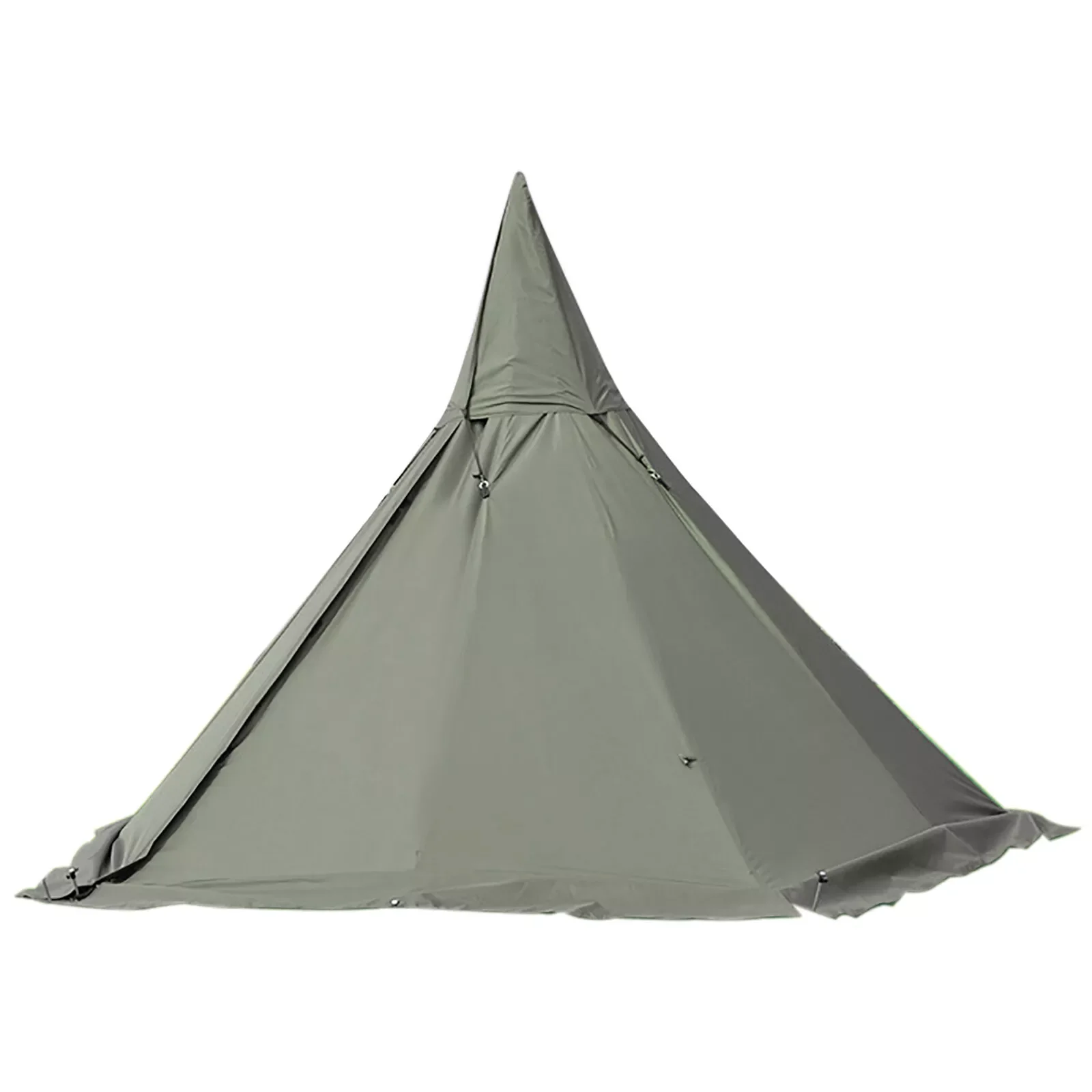
Teepee (also spelled tipi) and bell tents represent some of the oldest tent designs still in popular use, drawing inspiration from traditional shelters used across cultures for centuries. Their defining characteristic is a single central pole that creates impressive peak heights—often 7 to 9 feet (213-274 cm) at the center.
These conical or bell-shaped tents create a unique interior space with a dramatic peak and gradually sloping walls. The design creates exceptional headroom at the center, though usable standing space diminishes rapidly as you move toward the edges due to the sloping walls.
Teepee designs typically feature a simpler conical shape, while bell tents include a vertical sidewall around the base before sloping upward, creating more usable interior space. Both styles have seen a resurgence in popularity, particularly among glamping enthusiasts who appreciate their distinctive aesthetic and spacious feel.
Unique advantages:
– Striking visual appearance that stands out at any campsite
– Exceptional central height that creates an airy, spacious feeling
– Excellent ventilation options, often including a top vent at the peak
– Some models accommodate wood stoves via chimney openings
– Single-pole simplicity in basic designs
Specific considerations:
– Central pole creates an obstruction in the middle of the living space
– Requires adequate space for the large, circular footprint
– Setup requires careful tensioning of multiple guy lines
– Can be challenging to pitch on uneven ground
– Material choice significantly impacts performance (canvas or polyester)
These designs excel for base camping, extended stays, or when camping aesthetics are as important as function. Their impressive height and unique layout create a communal gathering space different from any other tent type.
Inflatable Tents: Air Beam Technology with Vertical Walls
One of the most innovative developments in tall tent design is the air beam or inflatable tent. These shelters replace traditional rigid poles with inflatable tubes or “beams” that provide structure when pumped with air. This technology enables designs with near-vertical walls similar to cabin tents but with remarkably simple setup.
Modern inflatable tents offer impressive headroom, with typical peak heights between 6 and 7 feet (183-213 cm). The best designs create cabin-like interior spaces with 60-80% of the floor area at standing height. Setup typically takes 5-10 minutes with an appropriate pump, though the initial inflation requires some effort.
Key advantages:
– Exceptional stability in wind due to flexible but strong air beams
– No rigid poles to break or lose
– Simplified setup process once technique is mastered
– Available in various configurations including cabin, tunnel, and hybrid designs
– Often incorporate multiple rooms and substantial vestibules
Limitations to consider:
– Higher weight compared to traditional pole tents (typically 30+ pounds/13.6+ kg)
– Premium price point reflecting the advanced technology
– Reliance on pumps (manual or electric) for setup
– Potential for punctures, though repairs are straightforward
– More complex deflation and packing process
Whether a 2-person tent is actually big enough depends largely on space requirements and comfort expectations. For those seeking maximum interior space, inflatable technology allows for creative designs that maximize usable room.
Essential Features for Tall Tent Comfort and Performance
When evaluating tall tents, certain features become particularly important for maximizing the benefits of the additional headroom:
Floor dimensions and shape
– Rectangular floors utilize vertical wall space more efficiently than square designs
– Allow at least 20 square feet (1.85 square meters) per person for comfort
– Consider how floor shape interacts with peak location to determine standing areas
Door design
– Door height should be at least 5‘6” (168 cm), ideally 6+ feet (183+ cm)
– D-shaped or house-style doors provide easier entry/exit than triangular designs
– Multiple doors reduce traffic congestion in larger tents
– Consider zippered mesh for improved ventilation options
Window placement
– Windows positioned higher on vertical walls offer better airflow
– Adjustable coverage allows weather protection while maintaining ventilation
– Mesh panels at roof peaks help remove hot air that rises in tall tents
Weather protection considerations
– Larger rain flies need adequate tensioning to prevent water pooling
– More vertical surfaces catch wind more easily, requiring proper staking
– Consider seasonal appropriateness—many tall tents are three-season designs
Structural considerations
– Frame strength becomes increasingly important as tent height increases
– Look for reinforced pole connections and multiple attachment points
– Steel poles offer greater stability but add weight compared to fiberglass or aluminum
The benefits of high ceiling tents extend beyond simple standing room to include better air circulation, more comfortable living space, and improved overall camping enjoyment, particularly during extended stays or inclement weather.
How to Choose Your Ideal Tall Tent: Decision Framework
With so many tall tent options available, a systematic approach to selection helps narrow down the choices based on your specific needs:
Step 1: Determine your space requirements
– How many people will regularly use the tent?
– Do you need separate sleeping and living areas?
– Will you store gear inside the tent or in a separate vestibule?
Step 2: Consider your camping conditions
– What seasons will you primarily camp in?
– Are your destinations typically windy, rainy, or calm?
– Will you camp in established campgrounds or more remote locations?
Step 3: Evaluate practical constraints
– How much vehicle space do you have for transporting the packed tent?
– What’s your physical capacity for carrying and setting up larger shelters?
– How frequently will you set up and take down the tent?
Step 4: Determine feature priorities
– Is setup speed more important than maximum headroom?
– Do you prefer more windows or better storm protection?
– Are separate rooms necessary for privacy?
Choosing the ultimate compact shelter for two involves different considerations than selecting a tall tent for larger groups, where standing height becomes more crucial for comfort over multiple days.
Based on your answers, you can identify which tent type aligns best with your priorities:
– Value maximum standing space throughout → Cabin tent
– Prioritize weather resistance with decent headroom → Enhanced dome tent
– Need quick setup with good height → Instant tent
– Want unique aesthetic with great center height → Bell/teepee tent
– Desire easiest possible setup of a tall shelter → Inflatable tent
Recommended Tall Tents for Different Camping Scenarios
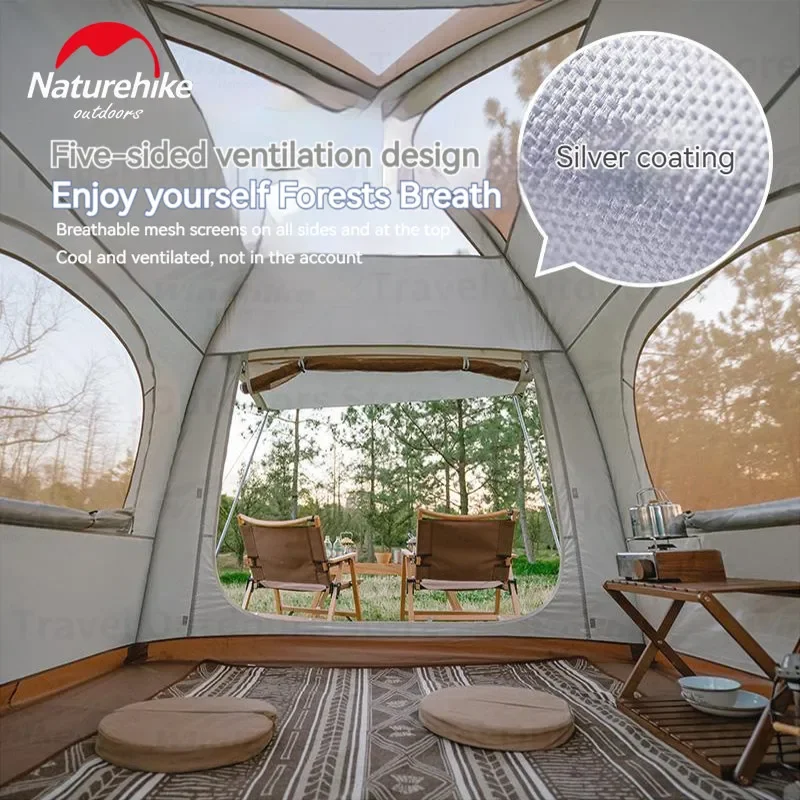
Based on different camping scenarios, here are recommendations for tall tent types that excel in specific situations:
Best overall tall tent for family car camping
Look for a cabin-style tent with 6‘6” (198 cm) or greater peak height, 80+ square feet (7.4+ square meters) of floor space, and room dividers for privacy. Models with multiple doors reduce traffic congestion, while mesh ceiling panels improve ventilation. Expect to invest $200-400 for quality construction that will last multiple seasons.
Best tall tent for quick weekend getaways
An instant cabin tent with 6’+ (183+ cm) peak height offers the ideal combination of setup speed (under 2 minutes) and comfortable standing room. Look for models with pre-attached poles, reduced mesh to retain warmth on cool nights, and a packed size that easily fits in smaller vehicles. Mid-range options typically cost $150-300.
Best tall tent for extended campsite living
For longer stays, a tunnel tent with near-vertical walls and 6‘2”+ (188+ cm) peak height provides efficient living space with better weather resistance than cabin designs. Key features should include multiple rooms, large vestibules for gear storage, and numerous ventilation options. Premium models range from $300-600 but offer exceptional livability.
Tall / Stand Up Camping Tent, Two Room Camping Tent
$407.93 Select options This product has multiple variants. The options may be chosen on the product page- $476.52 Select options This product has multiple variants. The options may be chosen on the product page
Easy Setup Camping Tent, Instant Camping Tent
Instant Cabin Tent Double Layer Canvas 1-Minute Setup Spacious Family Camping Shelter with Air Vents$308.10 Select options This product has multiple variants. The options may be chosen on the product pageEasy Setup Camping Tent, Instant Camping Tent, Lightweight Pop Up Tent, Pop Up Dome Tent
$252.30 Select options This product has multiple variants. The options may be chosen on the product pageDome Camping Tent, Easy Setup Camping Tent, Pop Up Dome Tent, Waterproof Pop Up Tent
$162.68 Select options This product has multiple variants. The options may be chosen on the product page
Best tall tent for challenging weather conditions
Enhanced-height dome tents with 6’+ (183+ cm) center height offer better stability in wind while still providing standing room in the center. Look for aluminum poles, full-coverage rain flies, and reinforced stake points. Quality weather-resistant options typically range from $200-400.
Best budget-friendly tall tent with good headroom
Modified dome or basic cabin tents with simpler pole structures can provide 6’+ (183+ cm) peak heights at more affordable price points ($100-200). While they may offer less standing area or fewer features, they deliver the core benefit of being able to stand upright without the premium price.
Tall Tent Accessories: Maximizing Your Vertical Space
Once you’ve selected the perfect tall tent, several accessories can help you take full advantage of the additional headroom:
Vertical storage solutions
– Hanging organizers that attach to ceiling loops or pole intersections
– Corner shelving systems that utilize vertical wall space
– Gear lofts that create overhead storage without impeding standing height
– Hook systems for hanging lanterns, clothes, or towels
Appropriate furniture
– Camp chairs with 19-22 inch (48-56 cm) seat heights for comfortable sitting
– Folding tables at standard heights (28-30 inches/71-76 cm)
– Cots (typically 15-19 inches/38-48 cm tall) that keep you off the ground while benefiting from headroom above
Lighting optimized for taller spaces
– String lights that can be mounted near the ceiling
– Lanterns with adjustable hanging heights
– Directional lighting that can be aimed where needed
Climate management
– Battery-powered fans that can be positioned at various heights
– Reflective ceiling panels for temperature management
– Ventilation accessories that take advantage of higher roof peaks
These accessories not only enhance comfort but also help organize your camping space more efficiently, taking full advantage of the increased volume that tall tents provide.
Setting Up and Maintaining Your Tall Tent: Special Considerations
Tall tents come with specific setup and maintenance challenges that differ from lower-profile designs:
Site selection becomes more critical
– Look for clear overhead space free from branches
– Choose level ground with adequate space for larger footprints
– Consider wind direction and position tent with lowest profile facing prevailing winds
– Ensure adequate space (minimum 6 feet/1.8 meters) around the tent for guy lines
Wind stability techniques
– Use all stake points and guy lines, even in calm conditions
– Position guy lines at approximately 45-degree angles for maximum effectiveness
– Consider additional guy lines for taller tent sections in windy areas
– Use stakes appropriate for your ground conditions (longer stakes for soft soil)
Setup strategies
– Position the tent body before extending to full height
– Start with the central or main support poles first
– Work with a partner when possible, especially for cabin and tunnel designs
– Practice setup at home before your camping trip
Storage and cleaning
– Allow complete drying before packing to prevent mildew
– Clean dirt from stake points and zippers after each use
– Store larger tents in loose rolls rather than tight folds to prevent crease damage
– Consider specialized storage bags with extra room rather than factory bags
With proper care and setup, tall tents can provide many seasons of comfortable camping despite their larger size and more complex structures.
Final Thoughts: Enjoying the Freedom of Standing Room
The ability to stand upright inside your tent transforms car camping from merely sleeping outdoors to truly living outdoors. This simple change—from hunching to standing freely—reduces physical strain, improves mood, and creates a more home-like environment in the wilderness.
When choosing between different tall tent designs, remember that the perfect tent balances your specific needs for space, weather protection, convenience, and budget. Cabin tents offer maximum standing area, enhanced domes provide better stability, instant tents prioritize convenience, and specialized designs like bell tents or inflatable shelters each have unique advantages for specific camping styles.
Rather than automatically choosing the tallest tent available, consider how you’ll use the space and which design features matter most for your camping habits. The most satisfying choice often isn’t the absolute tallest option but the one that best balances height with your other priorities.
By investing in a quality tall tent suited to your needs, you’ll create a comfortable base camp that enhances every aspect of your outdoor adventures. Two-room camping tents with standing height throughout can transform family camping trips into comfortable outdoor living experiences that everyone will enjoy.
With the right tall tent as your home away from home, you can focus less on accommodating to your shelter and more on enjoying the natural world around you—which is, after all, why we go camping in the first place.

